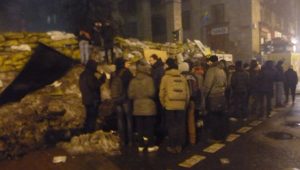T he text “War and Anarchists”, recently released by comrades from Ukraine, has already been widely distributed. If you haven’t read it yet, now is the time. Time to write reviews. Today is an actual date: the anniversary of the start of the final clashes on the Maidan on February 18, 2014, after which a new stage began in the history of Ukraine and the entire post-Soviet space.
he text “War and Anarchists”, recently released by comrades from Ukraine, has already been widely distributed. If you haven’t read it yet, now is the time. Time to write reviews. Today is an actual date: the anniversary of the start of the final clashes on the Maidan on February 18, 2014, after which a new stage began in the history of Ukraine and the entire post-Soviet space.
The text is very interesting. Its strongest point is factology, chronological outline and details. Something we learned from for the first time. We learned something from this text for the first time. An interesting ending about the current position of libertarians in the country. However, some parts of the text require critical comments:
– “The level of violence [on the Maidan] was high, the protesters had nowhere to retreat, so they had to stand to the end” (c) – There was a place to retreat, Maidan was not a besieged fortress.
The higher level of resistance than in Russia and Belarus is due to:
- A smaller scale of repression and arbitrariness on the part of the police in the pre-Maidan period;
- The presence among the protesters of organized groups ready to use force. Their total number was not so small, and these structures existed for more than one year;
- In general, the greater “impudent” and “non-intimidation” of Ukrainian society, where representatives of the authorities have never been looked at as celestials in the post-Soviet period.
– Perhaps the most vulnerable point of the publication is the almost complete lack of reflection on the internal politics and social structure of Ukraine. For example, the post-Maidan Verkhovna Rada itself, gave trump cards to the representatives “Russian world” with its “bill No. 5670-d”, aimed at restricting the use of the Russian language. Some pro-Putin Crimeans point to better social security than Ukraine under the new order. This does not in the least whitewash the Putin regime, which has taken money from other Russian regions for its populism in Crimea. But only poverty in Ukraine is associated with its neoliberal way of life, the lack of labor protection and real control of society over those in power. These phenomena did not disappear, and partly even worsened after the Maidan.
– It is not very clear why to focus on memes about “Jewish-Bandera” when there were orders of magnitude fewer users of these memes on the Maidan than the real admirers of Bandera, organized and purposeful. It was their work to promote the ultra-right agenda, and not at all that “trolling got out of control” (c), that allowed the pro-Putin propagandists to paint the Maidan as a fascist rebellion, and not a popular uprising.
– Surprising is the assertion that anarchists represent “the most radical approaches and views in the democratic camp”, and the somewhat dubious (at least unprovable) thesis that “Russia has long-term plans to destroy democracy in Europe” (which is usually voiced by extreme liberals). First, the very concept of “democracy” is extremely general and speculative. In modern political usage, this is usually called liberalism/neoliberalism. To put it simply: representative democracy in politics + capitalism in the economy. It is clear that this is not at all what the anarchists are a part of, nor is it what we should be pursuit for in Europe.
In general, one cannot but rejoice at the desire of the comrades who wrote the text to actively intervene in politics and participate in the fight against Putin’s imperialism, which, as we have already written, is a good thing. However, a revolutionary and libertarian stance on the situation still needs a lot of work. We hope that through joint efforts and comradely discussion, our community will eventually develop it.
The photo shows a group of anarchists on the Maidan in 2014, an illustration from the article.
